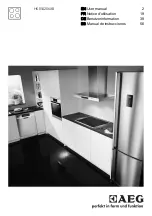
7.2. Commissioning of the stove
7.3. . Preparation of premises to installation of the stove
ATTENTION! At the time of the first heating of the stove applied on the metal industrial oils and light
volatile compounds of organosilicone enamel evolve smoke and smell, which aren't evolved in the
following.
People having chest troubles and owners of the pets susceptible to smoke (for example birds) should take
precaution measures.
The first heating of the stove it is necessary making open-air with fire prevention discipline, at least one hour,
with charging of a fire box in half in the regime of active combustion.
For correct operation of the stove, at the time of the first heating it is necessary to organize a temporary flue
with height at least 2m.
For the model of stove with built-in heat exchange unit it is necessary to organize temporary water heating
system during the first pre-heating.
ATTENTION! Don't make mechanical action to a surface of a stove till complete cooling and final
polymerization of paint at the time of the first heating in order to avoid damage of a lacquer coating.
ATTENTION!
To avoid the seal sticking to the stove body
, the first
firing should be performed with open ash
drawer.
Make sure
that
all elements of the stove are in safe conditions. Never use the faulty stove
.
Fault free stove
:
n
without visible body damages
.
n
the door hinges freely
,
fits
tight
ly
to the body and securely lock
ed
.
n
there
is
a
peripheral sealing cord in the door cavity
.
n
the door glass without cracks, chips or other damage.
n
the firebox protection and grate without damage, burnouts and cracks
.
n
the ash drawer moves freely and fits tightly to the body in the closed position.
n
the fine adjustment valve flap rotates freely and tightly covers
the opening in the closed position.
n
the heat exchanger
tank is sealed,
without
cracks or leaks.
Place the stove
on a specially
prepared place for its operation.
Protect from fire constructions of premises:
n
Walls (or partition) of inflammable materials have to be protected with plaster with thickness 25 mm on
an expanded metal or a metal plate on an asbestos paper with thickness 10 mm, from a floor to a level of
250 mm above the top of the stove.
n
A wall (or partition), through which fuel channel pass, shall be from nonflammable materials from a
floor to a level of 250 mm above the top of the stove. Recommended thickness of a wall is 125 mm.
n
A floor under the stove has to be protected by a foundation from brick at least two coating or other
nonflammable material at a distance of 380 mm from a wall of the stove.
n
A floor of inflammable and combustible with difficulty materials in front of a door of a combustor has to
be protected with a metal plate with size 700
?
500 mm with length its
side along the stove.
n
Make a fireproof partition in a passage of a flue through a ceiling.
n
At the time of installation of a flue in premises with a roof of inflammable materials a flue has to be
protected with a spark arrester of gauze with an opening wit
h size no more 5
?
5 mm, also have to block
with nonflammable roofing materials a space around a chimney.
ATTENTION! A place of installation the stove and chimney will be done in accordance with SNIP (ÑÍèÏ)
(construction norms and rules) 41-01-2003 or, in accordance with technical standards of a country,
where the stove would be exploited.
Summary of Contents for Battery Fire 11
Page 1: ...Battery Fire USER MANUAL ...






































